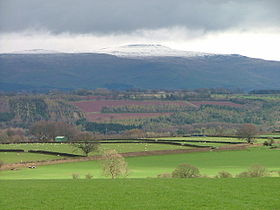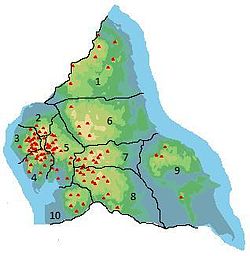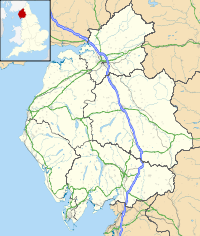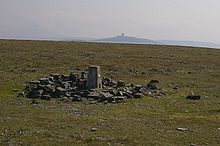- Cross Fell
-
Cross Fell 
Cross Fell seen from the Eden ValleyElevation 893 m (2,930 ft) Prominence 651 m (2,136 ft) Parent peak Helvellyn Listing Hewitt, Marilyn, Nuttall Location Location of Cross Fell in Cumbria Location North Pennines, England Coordinates 54°42′10″N 2°29′14″W / 54.70278°N 2.48722°WCoordinates: 54°42′10″N 2°29′14″W / 54.70278°N 2.48722°W Topo map OS Landranger 91 OS grid NY687343 Cross Fell is the highest point in the Pennine Hills of northern England and the highest point in England outside of the Lake District.
The summit, at 893 metres (2,930 ft), is a stony plateau, part of a 12.5 km (7.8 mi) long ridge running North West to South East, which also incorporates Little Dun Fell at 842 metres (2,762 ft) and Great Dun Fell at 849 metres (2,785 ft). The three adjoining fells form an escarpment that rises steeply above the Eden Valley on its south western side and drops off more gently on its north eastern side towards the South Tyne and Tees Valleys.
Cross Fell summit is crowned by a cross-shaped dry-stone shelter. On a clear day there are excellent views from the summit across the Eden Valley to the mountains of the Lake District. On the northern side of Cross Fell there are also fine views across the Solway Firth to the Southern Uplands of Scotland.
The fell is prone to dense hill fog and fierce winds. A shrieking noise induced by the Helm Wind is a characteristic of the locality.[note 1] It can be an inhospitable place for much of the year. In ancient times it was known as "Fiends Fell" and believed to be the haunt of evil spirits. It has been speculated that this last feature may be why the fell became known as Cross Fell ("cross" meaning "angry").[2][dead link]
A conspicuous local feature is the golf ball shaped radar installation on the summit of Great Dun Fell. This was built in the 1980s and supports civil air traffic control over the North Atlantic. The original site was built on the summit in 1949.
Contents
Local geography
Cross Fell and the adjoining fells are mainly a bed of hard, carboniferous limestone. Where this bed surfaces, there are steep rock faces. There are also strata of shale and gritstone that surface on the fell. On the south and west facing slopes of Cross Fell the rock faces have been broken up by frost action to give a scree slope made up of large boulders. The local terrain shows obvious evidence of recent glaciation and is covered by thin soil and acidic peat.
Cross Fell, Great Dun Fell and Little Dun Fell form a block of high terrain which is all over 800 metres (2,625 ft) in altitude. This is the largest block of high ground in England and tends to retain snow-cover longer than neighbouring areas. Snow can be found in gullies on the north side of Cross Fell as late as May in most years. In some years, lying snow has been known to persist until July and fresh snowfall in June (mid-summer in the Northern Hemisphere) is common.
Precipitation on Cross Fell averages around 280 centimetres (110 in) per year. Local flora includes a number of rare alpine plants such as the Starry Saxifrage and a mountain Forget-me-not.[3] Cross Fell is covered by what is known as "siliceous alpine and boreal grassland". It is the southernmost outlier of this vegetation type, which is common to highlands in Scotland and Scandinavia. It is a designated Special Area of Conservation (SAC). Local farmers are required to keep free-roaming sheep off the tops of the fells in order to avoid damaging the natural flora.[4]
Cross Fell is a conspicuous feature in the landscape. It dominates the skyline on almost the entire 20 miles (32 km) length of the A66 trunk road between Penrith and Stainmore. It can also be seen from Helvellyn summit in the Lake District and from high ground throughout Dumfriesshire and Northumberland.
References
- ^ "The Helm Wind Dufton Village Cumbria". www.dufton.org.uk. http://www.dufton.org.uk/the_helm_bar.htm.
- ^ North Pennines AONB Partnership article on Cross Fell
- ^ Cumbrian Wildlife: plants[dead link]
- ^ "SAC selection - 6150 Siliceous alpine and boreal grasslands". www.jncc.gov.uk. Joint Nature Conservation Committee. Moor House – Upper Teesdale. http://www.jncc.gov.uk/ProtectedSites/SACselection/habitat.asp?FeatureIntCode=H6150.
Notes
External links
- Panoramas
- Jonathan de Ferranti. "Cross Fell, North Pennines". www.viewfinderpanoramas.org. http://www.viewfinderpanoramas.org/panoramas/ENG/Cross.gif.
Marilyns Hewitts Bink Moss · Black Fell · Burtree Fell · Chapelfell Top · Dead Stones · Flinty Fell · Great Dun Fell · Great Stony Hill · Grey Nag · Killhope Law · Knock Fell · Little Dun Fell · Little Fell · Meldon Hill · Melmerby Fell · Murton Fell · Round Hill · The Dodd · Three Pikes · Viewing Hill · Westernhope MoorOther hills Knock PikeMarilyns of Northern England 1. Northumberland 
2. Northern Lakeland 3. Western Lakeland Blake Fell • Dale Head • Dent • Grasmoor • Great Gable • Grisedale Pike • High Stile • Kirk Fell • Lord's Seat • Low Fell • Mellbreak • Pillar • Robinson • Seatallan • Swinside • Watch Hill4. Central and
Southern LakelandBlack Combe • Claife Heights • Coniston Old Man • Hard Knott • Harter Fell • High Raise • High Rigg • Holme Fell • Illgill Head • Kirkby Moor • Lingmoor Fell • Loughrigg Fell • Muncaster Fell • Pike of Blisco • Scafell Pike • Top o' Selside • Whitfell5. Eastern Lakeland Arnside Knott • Fairfield • Grayrigg Forest • Great Mell Fell • Gummer's How • Hallin Fell • Helvellyn • High Street • Hutton Roof Crags • Lambrigg Fell • Little Mell Fell • Place Fell • Red Screes • St Sunday Crag • Seat Sandal • Stony Cove Pike • Tarn Crag • Wansfell • Whitbarrow6. North Pennines
and Durham7. Northern Yorkshire Dales Baugh Fell • The Calf • Great Shunner Fell • Hoove • Kisdon • Nine Standards Rigg • Rogan's Seat • Wild Boar Fell • Yarlside8. Southern Yorkshire Dales Aye Gill Pike • Birks Fell • Buckden Pike • Calf Top • Cracoe Fell • Dodd Fell Hill • Fountains Fell • Great Coum • Great Knoutberry Hill • Great Whernside • Ingleborough • Pen-y-ghent • Rombald's Moor • Sharp Haw • Whernside9. North York Moors
to the Humber10. Forest of Bowland Categories:- Marilyns of England
- Hewitts of England
- Mountains and hills of the Pennines
- Mountains and hills of Cumbria
- Nuttalls
- Regionally Important Geological / Geomorphological Sites (RIGS) in Cumbria
Wikimedia Foundation. 2010.





